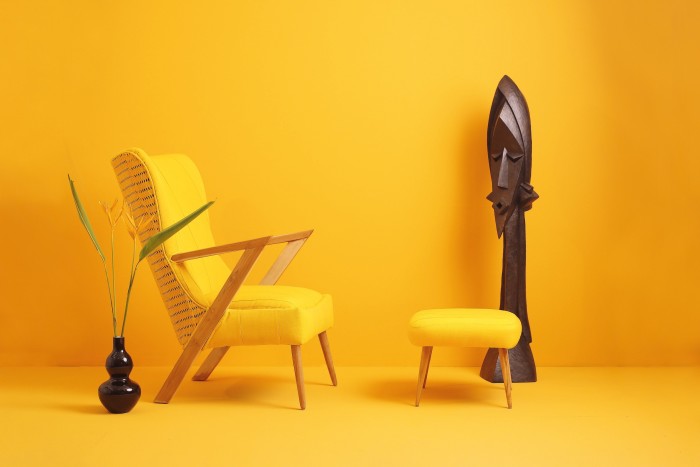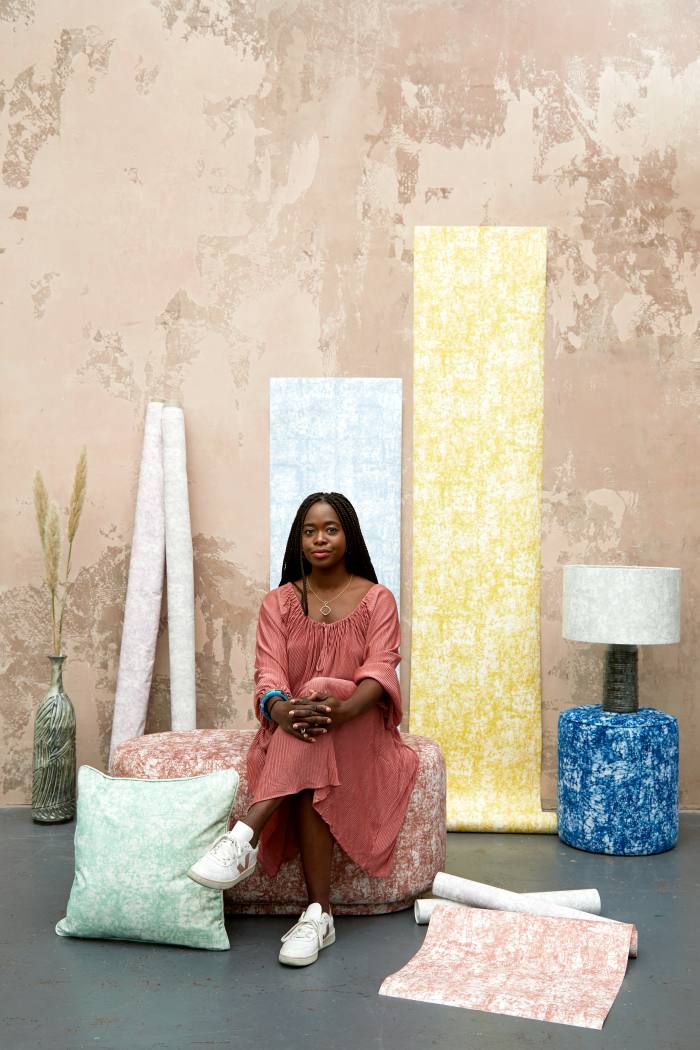Meet the creative forces reshaping the interiors landscape
The significance of African art, design and architecture in the age of modernism has for many years been downplayed. Often referenced as “inspiration”, African cultural tropes have been appropriated by many creatives in the west. But times are changing. From Afrobeats and Lagos Fashion Week to a new wave of creatives, designers from Africa and the diaspora are emerging as a major force in music, fashion and interiors.
The exhibition Africa Fashion at the V&A in London was a barometer of this shift. And the sparks of innovation are also igniting the international scene: Qatar’s 2022 Emerge exhibition introduced seven artists from Africa and the diaspora to Middle Eastern audiences; at Milan Design Week 2022, creatives such as Nigerian-American designer Ini Archibong stood out. Last month, the craft and design fair Collect at Somerset House showcased designers from Senegal, Zimbabwe, Ghana, Nigeria and beyond. “The quality of the work is outstanding, evidenced by the fact that the Brookfield Properties Craft Award, awarded at Collect each year, has featured several shortlisted artists from Africa,” says the Craft Council’s creative director Natalie Melton.
Tosin Oshinowo
Overcoming challenges often drives creativity – but it is key for Ilé Ilà, the furniture brand started by Tosin Oshinowo in 2017. “I grew up in the ’80s in Nigeria when we had a lot of military barricades. You were very aware that you had to learn to play with what you had – and that forces children to be creative. I was always making stuff with broomsticks, like kites…” says Oshinowo from her studio in Lagos. “I used to get frustrated that I would be limited as a designer but it’s been my blessing.”

I was always making stuff with broomsticks, like kites
Furniture designer Tosin Oshinowo
Oshinowo formally trained as an architect after the family noticed that she was gifted in fine art. “No African parent wants their children to end up being a singer or a musician or an artist. They think you won’t make any money. So, they say, OK, what’s the next best thing?” In 2012 she started her own firm, cmDesign Atelier (cmD+A), where she has led large-scale projects such as the Maryland Mall in Lagos but, in those early years, she also nurtured an interest in furniture design. The furniture collection responds decisively to the quandary of how to pull traditional elements of a culture into a modern environment. “How can we start to create in a way that celebrates Nigeria and its uniqueness? I live in a very modern city with a lot of vibrant cultures. My work is about trying to reclaim that,” she says.


Drawing inspiration from tropical modernism, the Ilé Ilà chairs reference postwar design. “I really liked the strength of these striking forms. Firstly, for the clarity of it, but also for the ability for it to be made locally,” she says, detailing a design process that is shepherded by what is and isn’t possible with local artisans who don’t have a lot of machinery. Her work with them is part of a self-imposed framework that prioritises local materials.
“All the fabric is done by local weavers; the wood is cut from a local forest and all the structure inside is made from locally available foam,” she says. She uses Aso Oke, a traditional textile. “It’s such a tough fabric and it lends itself elegantly to upholstery,” she explains. “I get to encapsulate and chronicle this beautiful history that is being preserved in fabric. I’m not only educating myself, I’m helping people to understand and celebrate their culture.” Pausing, she smiles: “I mean, it’s a win-win.” ile-ila.com Charlene Prempeh
Eva Sonaike
The German-born, London-based former journalist turned textiles and interior designer draws on her Yoruba heritage to create colourful collections of cushions, rugs, lamps, wallpapers and textiles. “They reflect the west African way of life. We have a very specific way of living, from the fabrics and colours we use, to our clothes and our celebrations,” she says.


Sonaike, 43, founded her eponymous company in 2009, and each collection begins with a narrative. “Kano, my most recent collection, is named after a city in northern Nigeria in Kano State, formerly a trans-Saharan trade route, which is a city of kings and queens [as the traditional state of the Dabo dynasty]. I envisaged a story – using textiles. I always start with the colours, which takes a long time because I want them to translate the story accurately. Then I design and create the overall package,” she says.

These stories, which also fuse influences from her German heritage, resonate with a global audience. Sonaike’s designs have been sold at London’s Selfridges, Liberty and Fenwick’s Bond Street, and she has collaborated with Soho House and Jo Malone. “I have showrooms in the US, Australia and Asia and work as an interior design consultant internationally,” she adds. She will also feature in series two of the Netflix documentary Made By Design, which airs later this year.
Sonaike is well aware of her position not just as a creative force but as a role model. “I am someone who holds a ‘black narrative’. I am a black woman, with a black-owned brand, and I am a recognised voice in a narrow, elitist industry, which I am pleased about. I hope this will open doors for others.” She is optimistic about the future: “We want to grow: we want more revenue, more representation and more visibility,” she says. “But for me, it’s much more important to bring other black designers and creatives on board – especially female designers. I’m here to give back.” evasonaike.com Yasmin Jones-Henry
Peter Mabeo
Peter Mabeo’s design journey was born of frustration. “There was no space for any sense of expression within a culture that sought to emulate first-world ideals as a means of separating oneself from the undesired ‘developing world’,” says the Botswana-based designer-entrepreneur. “This did not resonate, so I started to search for alternatives. The irony is that I had to look to the so-called first world.”

The 50-year-old furniture designer, who launched his eponymous brand in 2006, weaves the skills of local craftspeople and traditional techniques into his designs – which helps amplify their work. The exchange is one of “interaction, relating, deliberating and exchange”, says Mabeo, within a creative process that begins with “no preconceived idea of what a design ought to be”. Mabeo often works with artisans using local materials such as panga panga wood and hand-beaten metals. His approach has led to collaborations with international designers such as Patricia Urquiola and Claesson Koivisto Rune; most recently he attracted the attention of Fendi’s Kim Jones, Delfina Delettrez Fendi and Silvia Venturini Fendi, who oversees the brand’s Fendi Casa homewares division.


Mabeo unveiled his Kompa collection for the brand, produced by artisans in Botswana, at 2021’s Design Miami. “When superficial layers are peeled away, the craftspeople in the Fendi ateliers have a similar energy to us and we relate to that. I was hesitant to engage in a project with such a sizeable brand but when meeting Simon Parris from Kim Jones Studio, then Delfina Delettrez Fendi and Silvia Venturini Fendi, as well as Kim Jones, I realised that we all shared an interest in craft. There is push and pull, patience and deliberation, sometimes stepping back before continuing with the work.” There will be further Fendi Casa collaborations in the future. Some pieces will be made available through production in Italy, while a special limited edition will be offered through specific craft collaborations in Botswana. Mabeo hopes that such projects will promote “unexpected, meaningful and equitable exchanges between cultures”. @mabeofurniture YJ-H
Elodie Dérond and Tania Doumbe Fines
Tania Doumbe Fines, 28, an interior design graduate and self-taught artisan, met musician Elodie Dérond, 25, in 2018 after studying in Montreal, Canada. “During those five years, I was painting, studying and making music but then I saw Tania making a chair for an exhibition. I was like, ‘I want to help!’” Dérond says. This first project put the duo on a new path. As Doumbe Fines recalls: “We both fell in love with the process and decided to keep it going.”

“We have a good balance,” continues Cameroon-born Doumbe Fines of their creative partnership. “I am more academic and Elodie [who comes from Martinique] is more of a creative mind. I’m the brain and she’s the soul.” At Ibiyane – a name deriving from the Batanga meaning “to know one another”, the pair are creating sculptural objects, including mirrors and stools, that blur the boundaries between art and design. Last year, New York’s Carpenters Workshop Gallery presented their work in the exhibition The New Guard: Stories from the New World. The pieces on show were described as marrying “functionalism with the storytelling power of design to re-centre the canon on the heritage of the African diaspora”.


We consider our inspiration to come through conversations with our communities, from our cultures
Designer Elodie Dérond
They relocated to Martinique in 2020. “It’s the perfect option: Martinique is a balance between Montreal and Africa – the climate is close to my home in Cameroon, but here we have more structured opportunities. It’s the best of both worlds,” says Doumbe Fines. The pair are incredibly busy. They will be exhibiting at Milan Design Week this month and are developing their own collection. Doumbe Fines describes their aesthetic as “a contemplative study, aiming to translate intangible maps into three-dimensional poetry”. Dérond continues: “What we mean by translating intangible maps is that we consider our inspiration – everything that we are, and the memories that we hold – to come through conversations with our communities, from our cultures.” Doumbe Fines adds: “It’s the values that we carry with us, and how we can take that into a poetic form – into objects. These objects become vessels of our values, heritage and our beliefs.” @ibiyane; carpentersworkshopgallery.com/artists/ibiyane YJ-H
















